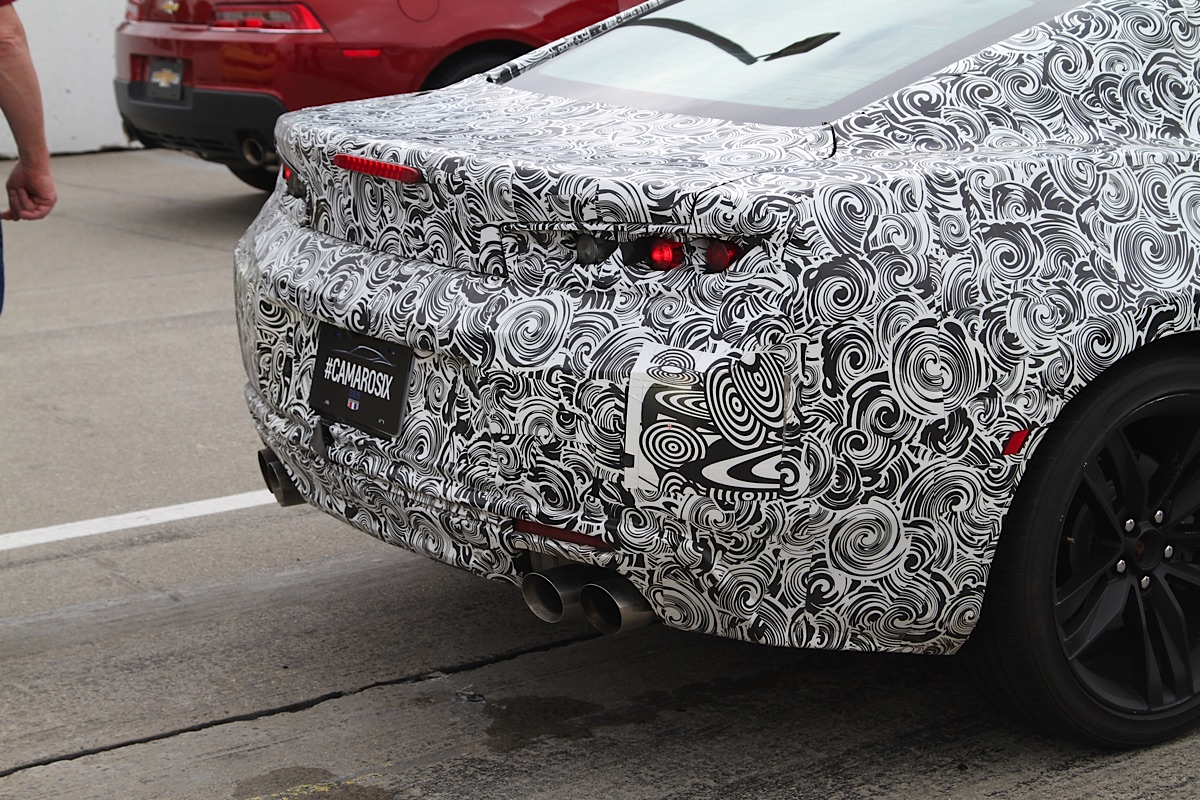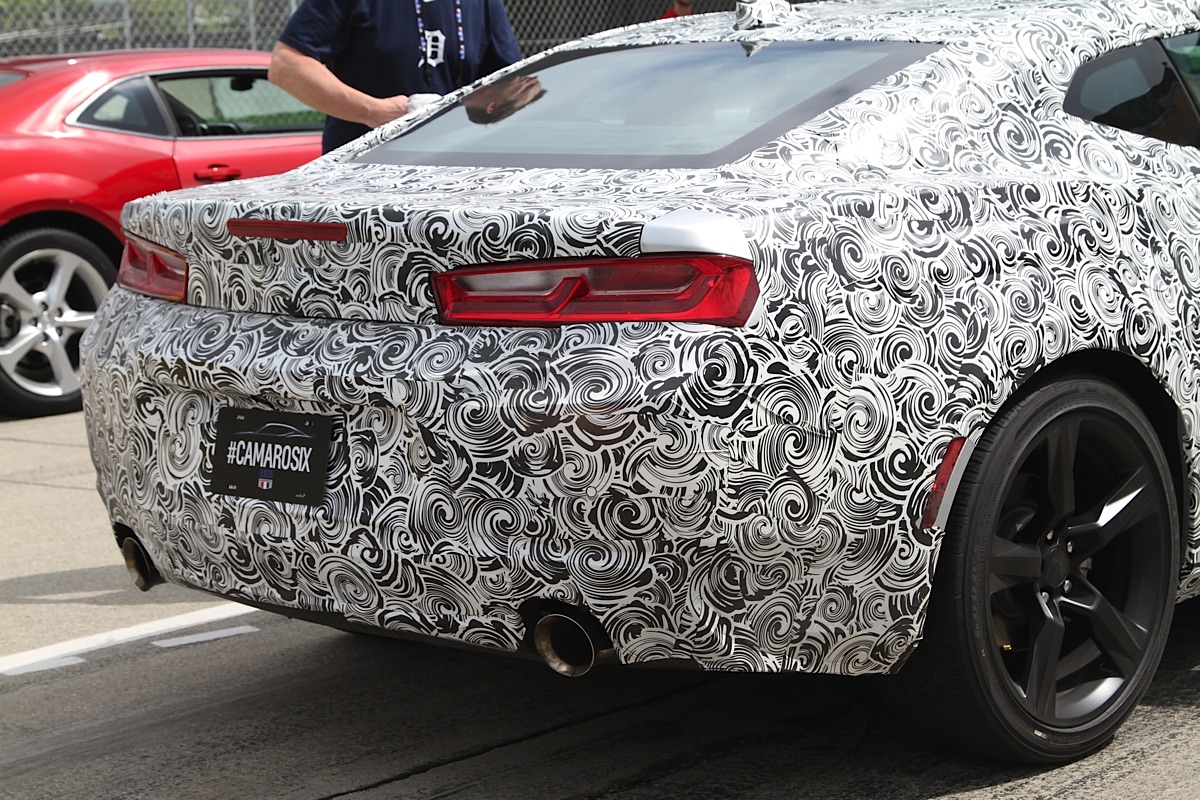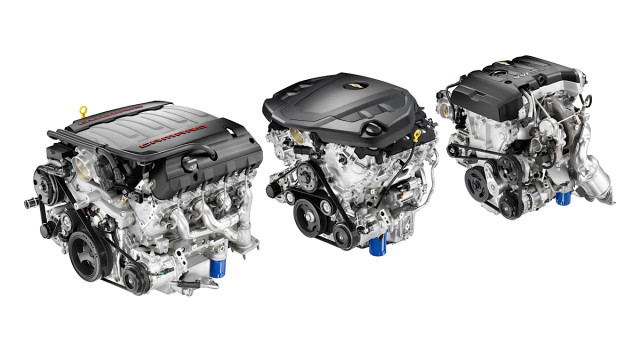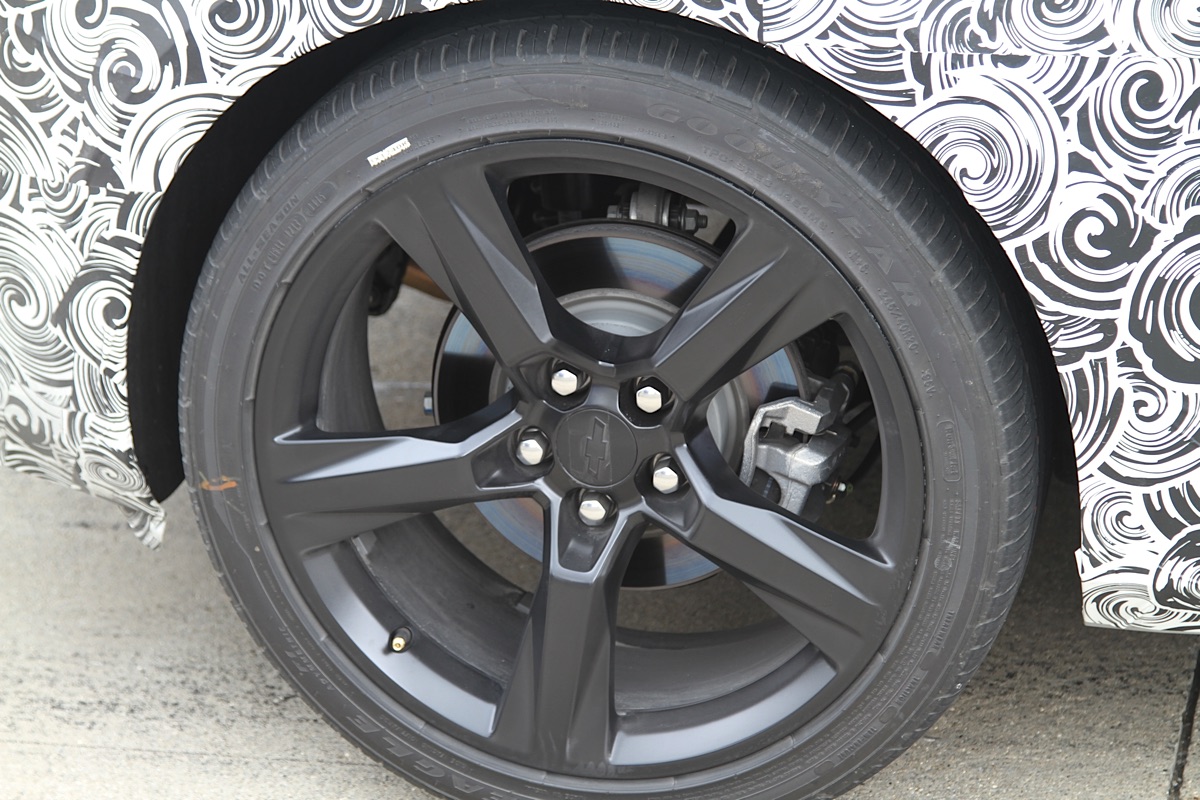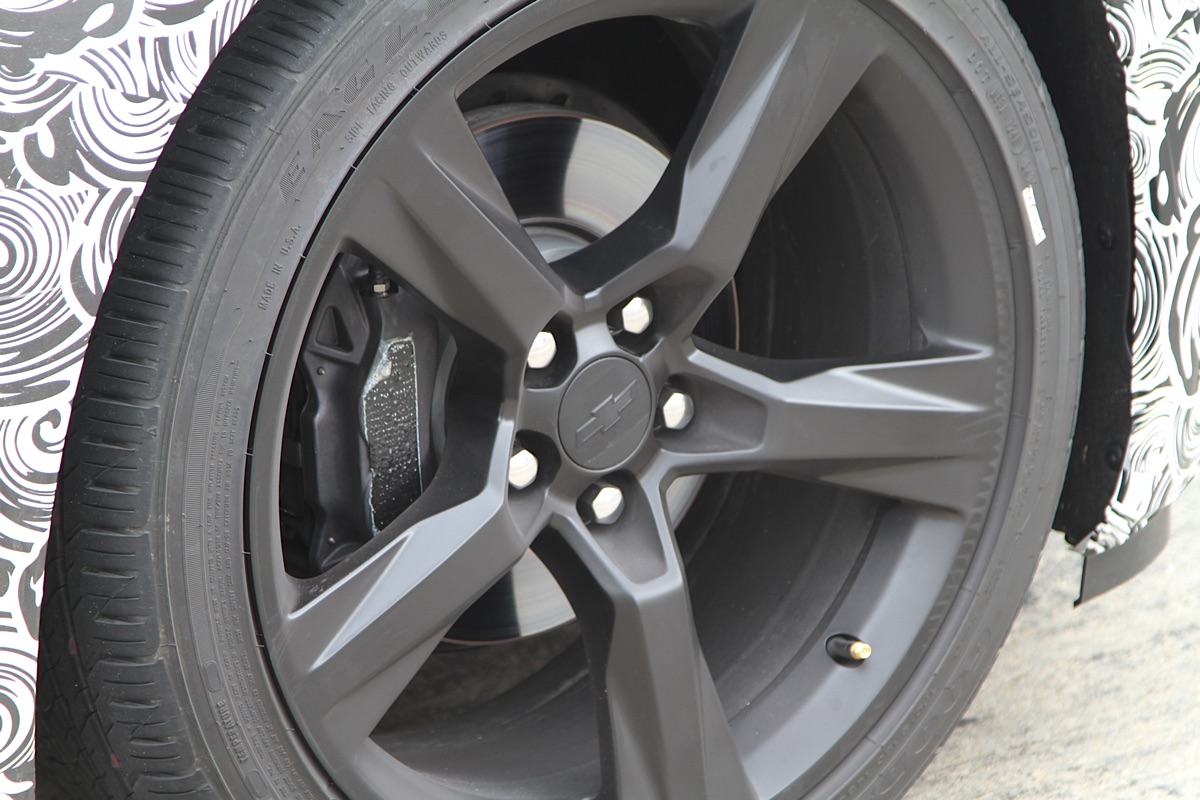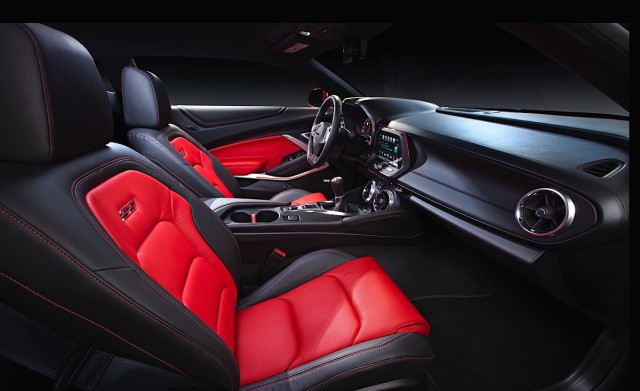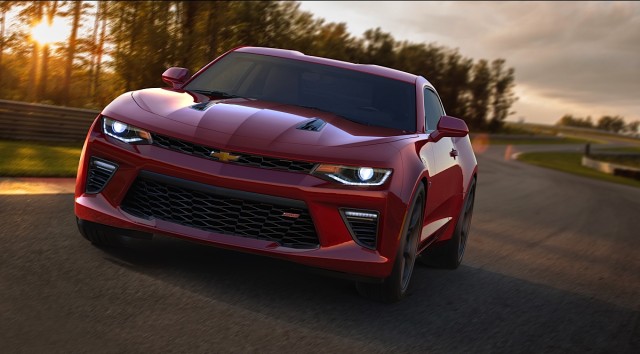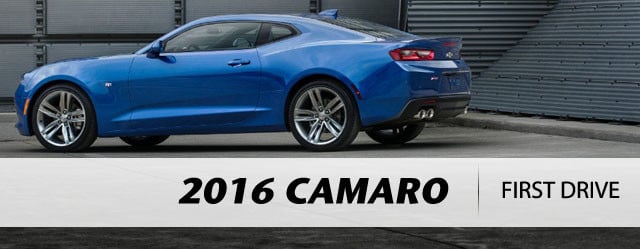 It’s just another day on the job; waiting in line with four dozen other automotive writers, waiting patiently for my turn to drive a preproduction 6th Gen Camaro. Nobody outside GM had “officially” seen one before yesterday, TV news channel goofs notwithstanding, and the cars still wear monochrome dazzle camouflage wraps.
It’s just another day on the job; waiting in line with four dozen other automotive writers, waiting patiently for my turn to drive a preproduction 6th Gen Camaro. Nobody outside GM had “officially” seen one before yesterday, TV news channel goofs notwithstanding, and the cars still wear monochrome dazzle camouflage wraps.
It’s very, very unusual for a car manufacturer to show a car to the public for the first time, then hand test mules over to the media the next day. Usually it’s weeks before anyone gets their first experience at the wheel, but today we’ll get a very rare (and very limited) chance to see what the next Camaro is like, very early in the production timeline.
Watch the Video:
GM says the cars will hit showrooms sometime in the 4th quarter of 2015, with six different powerplant and transmission combinations available. Top of the line is the LT1-powered SS, rated at 455 horsepower and 455 pound-feet, backed by your choice of a Tremec TR6060 6-speed manual with active rev matching, or the 8-speed 8L90 automatic that, along with the LT1 powerplant, first debuted in the C7 Corvette Stingray.
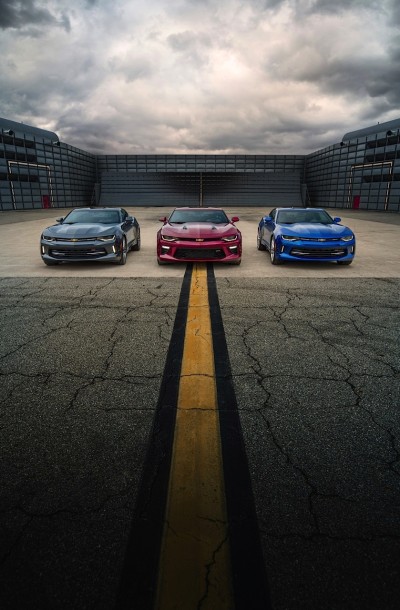
Chevy says that they are making a greater effort to visually distinguish the 2.0T, 3.6, and 6.2 models. Can you tell the difference?
The “entry level” 6th gen powerplant is the 2.0-liter turbo shared with the Cadillac ATS, among other vehicles in the GM roster. It’s rated at 275 horsepower and 295 pound-feet, and gets a six speed manual or eight speed automatic – the Tremec TR3160 or 8L45, respectively. Both are lighter and more compact than their counterparts in the V8 car, which makes sense. After all, the SS transmissions are the same ones that have to live through the warranty period when strapped to the C7 Z06’s 650 horsepower LT4, and there’s no need to have a tranny with a thousand Newton-meter rating backing a turbo four.
We won’t be driving either the SS or 4-cylinder cars today, though. All six of the camo’ed prototypes have the mid-line 3.6-liter direct injection DOHC V6 under the hood, and for comparison’s sake, Chevy is having us each take a lap in a 2015 Camaro V6 first, then jump straight into a 6th gen. It’s lead-and-follow, with groups of three following a 5th gen Z/28 like baby ducks trying to keep up with mama.
The format of the test drive is a necessity; we’re on the Belle Isle grand prix street course, with no runoff in any of the turns, and only the occasional tire wall in strategic spots to keep the overenthusiastic off the concrete. I remind myself of my commitment to make it through my professional writing career without crashing somebody else’s car as the line of waiting drivers inch forward.
Some of my peers are speed-shifting the 6th gens as the gaggle of cars start off down pit lane, chirping the tires to impress industry acquaintances they see maybe three or four times a year. The driving session staff, sourced from the Ron Fellows school, encourage the tail end drivers to not tarry with hand signals – they don’t want anyone to have a big gap that might let somebody get in over their head while trying to catch up to the group.
NPP RPO Camaros get quad tips that distinguish them from their bretheren. The multi-mode exhaust will be available on both V6 and V8 cars, but was nixed for the 2.0T - per Al Oppenheiser, the sound was too 'boy racer'
The V6 is available with the variable mode exhaust system, and it’s easy to tell which of the prototypes have it both visually thanks to the quad tips instead of duals, and by the raspy bark they emit when somebody’s instinct in the first ten seconds of driving it is to floor the gas pedal.
While the new six cylinder shares displacement with the 3.6 in the 5th gen, it’s a big jump up in terms of power and fuel economy. 335 horsepower and 284 pound-feet are on tap, and like the LT1 V8, Active Fuel Management is standard, turning the V6 into a V4 during light load conditions.
Unlike Ford, Chevy has chosen to position the V6 in the middle of their pony car lineup, which some people might see as a gamble. While the 5th gen V6 was undoubtedly a sales success, with many would-be Camaro buyers drawn into the showroom by the lure of the SS but leaving with a more budget-friendly RS, history hasn’t always been kind to four cylinder F-bodies. Will those star-struck but wallet-light potential owners see the turbo four as an also-ran if they can’t swing a V6 or SS?
“I think the 2-liter turbo is going to surprise people here internally, and I think it is going to surprise people in general,” opines Camaro Chief Engineer Al Oppenheiser. “The 2-liter is a sleeper – it’s a rock star. I would date myself, but I am probably one of the last guys you would expect to be touting a 2 liter four cylinder in a Camaro, because I remember the last one, which wasn’t a turbo. I remember the day when I walked into my manager’s office, and he closed the door, and I looked around and there’s all these powertrain people. And I thought, ‘oh, no – you’re the four cylinder guys! Let me out of here!’ but it was, ‘Here’s your Kool-Ade, Al!'”
I took the four cylinder out on the road and I was gone for like six hours driving it on the autobahn and country roads. – Al Oppenheiser, Camaro Chief Engineer
To start off, they let us take our “calibration” lap in a 2015 V6 Camaro. By the luck of the draw, I get an automatic. It’s pretty much what I have come to expect from the 5th gen, non-1LE, non-Z/28 Camaro. Climbing in, you can smell the brakes and feel the heat coming off. The cars don’t seem to enjoy being hot-lapped, even at a 6/10 pace. Following the lead car, the 2015 never lets you forget how heavy it is or how close the concrete barriers are. It’s frankly not much fun, because it feels like it is working so hard. This is not this Camaro’s Happy Place.
Oppenheiser uses terms like “leaner” and “less mass” whenever you ask him about the things the team sought to change from generation to generation. But his main talking point when it comes to the 2016 isn’t about shedding weight – it’s about personalizing the car. “Our strategy, versus our buddies in Dearborn, is that we feel that if you want to buy what you can afford, four, six, or eight cylinder, you should be able to option up the content the way you want,” he explains. “We aren’t going to force you into a four cylinder engine mid level trim to get the high level audio. You can buy a 2-liter turbo, get the ambient lighting, get the [driving] mode switch – we don’t want to stifle somebody and make [the base 4-cylinder] feel like an ‘excuse’ car. Option availability isn’t tied to what engine you have.”
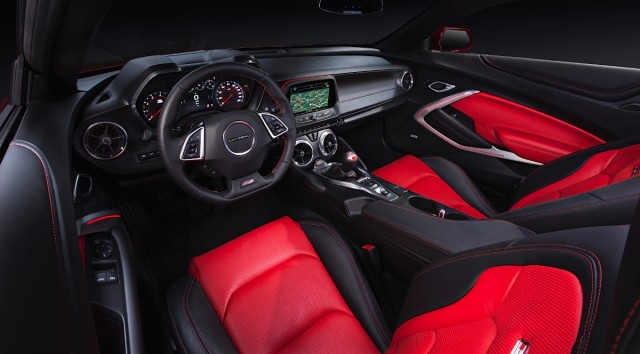
The biggest reaction from the crowd of fans during the introduction was when Mark Reuss announced that the 6th Gen would be available with customizable color accent lighting and a ‘car show’ mode…
The 2016’s “user interface,” for lack of a better term, is definitely long on customization. Like the C7 Stingray we reviewed, there is a lot going on with the dashboard display’s central LCD display, flanked by an analog tach and speedometer, and though we didn’t get enough time in the car to do any exploration, it promises to have a similar learning curve as well. Oppenheiser says they put a lot of thought into how drivers would interact with the different mode selections.
“Between snow/ice, tour, sport, and track, with all the damper settings and steering settings, throttle settings and lighting settings, it’s this big matrix, as you can imagine,” he explains. “We wondered, ‘Is this going to blow people away?’ What if they dig so deep into the customization that they can’t dig themselves out? So we made fail-safes and standard settings.”
They also made your customizations ‘persistent’ – Oppenheiser adds, “In the 5th generation, if you go to sport, and set things up the way you like, then park it in the garage, you start up the next morning and it keys up to Tour. This time, we latch over and your next ignition cycle saves what you had the last time you drove. That’s a detail we sweat with that big matrix I was talking about, and people really won’t realize it unless they compare the 5th to 6th.”
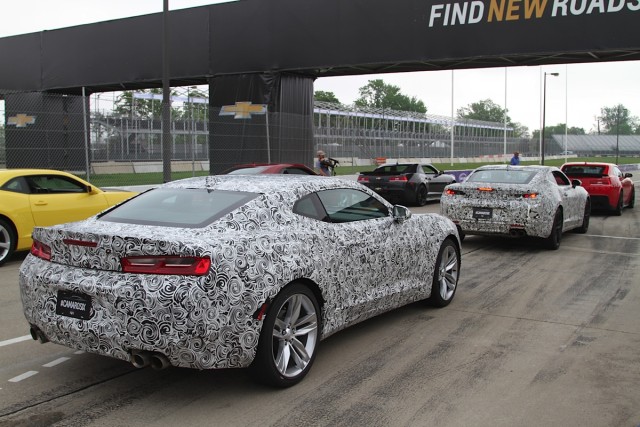
Look closely at the roofs of the these two 6th gen cars and you can see the difference between the solid roof version (front) which echoes the styling of the C7’s roof, and the one with a sunroof behind it.
Back in the pits after the lap in the 5th gen, and straight into the 6th. Run the seat all the way back (again) because the guy ahead of me was a foot shorter. Am I even going to fit in this thing? Al Oppenheiser and I stand the same height, so I am guessing any Camaro designed on his watch will fit somebody who’s 6′ 3″, and sure enough, I do.
The test mules' brakes got no mercy. You can see the color change on the rears, and good luck getting that gaff tape off of the front calipers (it's there to conceal the Camaro logo.)
Unfortunately this particular car has a sunroof taking a bite out of the headroom, so I do brush the headliner, but no worse than I do in a 5th gen. Seatbelt on, check the reach to the shifter (yay! it’s a stick car!), turn off the electronic parking brake (boo! where’s the drift handle?), and the lead driver is barking at us over the radio to get ready to go. There’s no time to appreciate the dash, the interior, or anything but the steering wheel, pedals, and shift knob before we set off again around Belle Isle.
Like the C7 Z06, transmission choice is going to be a hot topic for keyboard warriors with the 2016 Camaro. Per Oppenheiser, the take rate for the manual transmission in the 5th gen was only about 1 out of ever 4 cars (it’s not much better for the Corvette, which tops out at 37%, leading all other Chevy vehicles that offer the choice of auto or manual transmissions) but it’s not in danger of disappearing from the option list.
Per Oppenheiser, “The manual, in my opinion, gives you the driving experience you want in a Camaro. When you drive a manual, you want to be connected to the road. You pay more attention to the road, you have that clutch and throttle interaction. I would support doing a manual forever. It needs one. It’s still a key element in the Camaro design.”
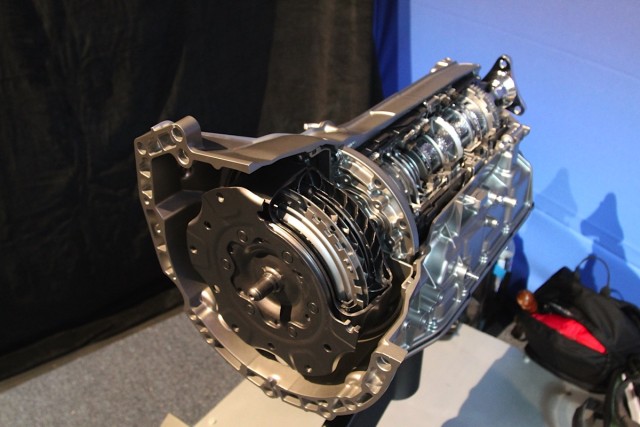
Much to the chagrin of some enthusiasts, the majority of 6th gen Camaros will be equipped with either the 8L45 (2.0 and 3.6) or 8L90 (LT1) automatics. As good as the 8-speed is in the Stingray, this isn’t cause for sadness.
The gearbox in the stick shift 6th gen is Tremec’s 6060 for SS models, and the 3160 backing the V6 and 2.0T – both six speed. Why not the 7-ratio box like the new Corvette? “Early on, we talked about it,” Oppenheiser admits. “My preference is to give you a long 5th gear – 7th gear is a fuel economy gear, and as you know, because I say it all the time, out of the top ten reasons people buy a Camaro, fuel economy is about number 23. I would rather do a gearset that gives you a good second gear, a long fifth, and the 6th becomes the fuel economy gear. Not just doing a 7-speed because a 7-speed is available. It really has to fit the DNA of the car.”
Out of the top ten reasons people buy a Camaro, fuel economy is about number 23. – Al Oppenheiser
Along the back straight that runs along the river, with Canada flashing past out the driver’s side window, the car gathers some decent speed. They’ve dropped brake marker cones on the track to give plenty of warning for the tight right that follows the left hand kink at the end of the straight, and it’s a good thing I heed them because the brakes are showing the strain of today’s hot-lapping with a bit of fade. A few more second-gear trips to the rev limiter around the remaining turns, and my first drive is done.
Is it the right time for a 30 MPG, four cylinder Camaro? Did the lineup need a third powertrain choice? It’s a less risky strategy than it looks to be at first glance, since both the four and V8 are shared across multiple platforms, and the revamped six is undoubtedly going to make it into a lot of other GM cars and trucks. Every 6th gen Camaro that rolls off the showroom floor without an LT1 under the hood helps the company’s fuel economy numbers.
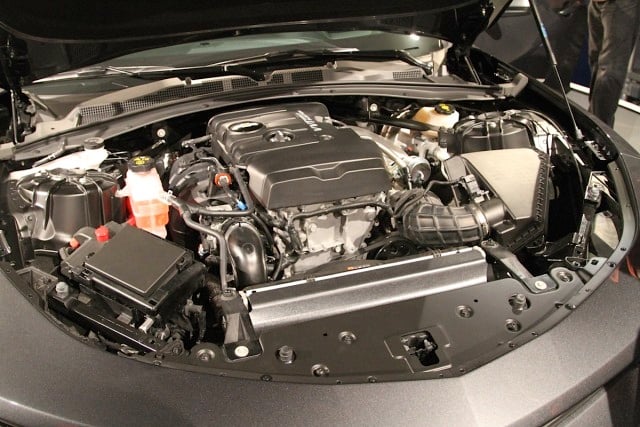
Tuners with experience tweaking the Cadillac ATS’ 2.0 turbo powerplant will feel right at home with the new Camaro. We predict that turbo swaps will be a very popular upgrade for this car.
“We have a corporate CAFE requirement for 2016, and a more stringent one for 2025,” says Oppenheiser. “If we don’t start getting the world to understand what that really means, we won’t be able to sell cars. We’re doing our part with this fuel-efficient 2-liter turbo. For the first time with the Camaro we are offering a V6 that has Active Fuel Management cylinder deactivation on our midlevel model, and when we have more cars with better fuel economy, guess what we can sell more of? You have to help yourself here.”
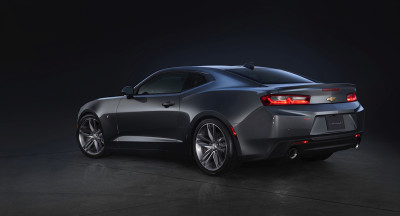
In person, the side windows seem even shorter than they look in photos. Surprisingly, from inside the car, the high beltline is a non-issue, though.
After my all-too-brief experience behind the wheel of the V6 6th gen, what stands out is what didn’t stand out: It was only after-the-fact that I realized I didn’t even notice the high beltline, C pillar position, or short side windows. Unlike a lot of other cars I’ve driven on-track, including C7 Corvettes and the outgoing Z/28, it didn’t take a few turns to settle in, figure out how to “interface” with the driver’s seat, door panel, and console to stay steady in the corners, and get comfortable at speed. The 2016 Camaro just seems to disappear around you, leaving only the wheel, pedals, and shifter upon which to focus your attention.
One lap of Belle Isle forces you to dive in and drive, with no time for introspection. I don’t know if that was Chevy’s intention or not, but it turned out to be the perfect way to demonstrate what a great platform the new Camaro is. I can’t wait to flog the 2.0T and LT1 versions to see if they’re just as fun and rewarding.



